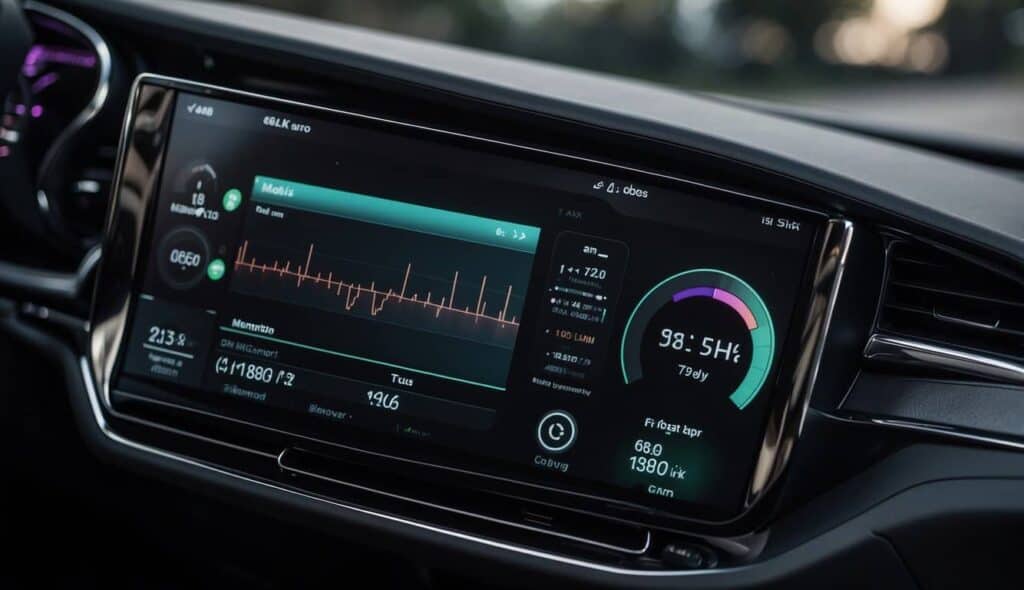To check your Tesla’s battery health, open the Tesla mobile app, go to the Service menu, and select Battery. Then, follow the prompts for a self-diagnosis. This feature helps you understand if your vehicle’s range is within normal parameters, ensuring you get the most out of your electric vehicle.
For those using the mobile app, the process is straightforward. By typing “loss of range” when asked to describe the problem, the app can provide a detailed assessment of the battery’s condition. This self-diagnosis tool offers a quick and reliable way to monitor your Tesla’s battery without needing a trip to the service center.
Keeping an eye on battery health not only ensures your car runs smoothly but also provides accurate range estimates, which can help you plan long-distance trips.
Understanding Tesla Battery Health
Tesla battery health is essential for ensuring a Tesla vehicle’s long life and efficiency. Here we explore the main components that affect battery health, Tesla’s Battery Management System (BMS), and the importance of lithium-ion technology.

Components of Tesla Battery
Tesla batteries consist of thousands of small lithium-ion cells grouped into modules and assembled into a battery pack. Each cell plays a critical role in overall battery performance.
The battery pack also includes cooling systems to prevent overheating. Proper temperature management is crucial as excessive heat can degrade battery life. Sensors monitor temperatures and adjust cooling as needed to maintain optimal performance.
Tesla’s Battery Management System (BMS)
The Battery Management System (BMS) is the brain behind Tesla’s battery health. It constantly monitors and manages the battery pack’s activities. The BMS ensures cells are charged and discharged evenly to maximize lifespan and efficiency.
It also provides safety features like overcharge and short-circuit protection. By balancing cell voltage and temperature, the BMS prevents damage and maintains optimal performance across different operating conditions.
The Role of Lithium-Ion in Battery Longevity
Lithium-ion batteries are known for their high energy density, which enables longer driving ranges. They handle frequent charging and discharging cycles better than other types of batteries, making them ideal for electric vehicles.
However, these batteries can degrade over time due to factors like charge cycles, temperature, and load. Tesla uses advanced chemistry and cooling techniques to slow this degradation, ensuring long-term battery health and performance.
Check out How Long To Charge Electric Car On 110v?
Monitoring Battery Health via Tesla Mobile App
Monitoring the health of your Tesla’s battery through the mobile app is an easy and essential task. It allows users to track battery health, interpret the State of Charge (SoC), and receive alerts and notifications.
Checking Battery Status on the Tesla App
To check a Tesla’s battery status, users need to use the Tesla Mobile App, available on the Google Play Store. First, open the app and ensure it is updated to the latest version.
Navigate to the Service menu, then select Request Service. Choose Battery, followed by Range. In the description field, enter “loss of range.” Tap Next and the app will automatically run a self-diagnosis to evaluate battery health.
This process quickly provides users with an assessment of their battery’s condition and any recommended actions. The vehicle’s touchscreen display may also be used for more detailed insights and diagnostics.
How to Interpret State of Charge (SoC)
State of Charge (SoC) is a key indicator of a Tesla battery’s health. It represents the remaining capacity in the battery relative to its maximum capacity.
In the Tesla Mobile App, SoC is displayed as a percentage. A higher percentage indicates a fuller battery. Typically, keeping the SoC within 20%-80% is recommended for optimal battery longevity.
Understanding the SoC helps users schedule charging sessions wisely and prevents the battery from being overused or underused. Regularly checking the SoC ensures the vehicle is always ready for use without straining the battery.
Alerts and Notifications
The Tesla Mobile App provides alerts and notifications related to the battery’s health. This includes warnings about significant loss of range, charging issues, and required maintenance.
Notifications are sent in real-time, allowing users to promptly address any problems. Additionally, these alerts can be viewed on the vehicle’s touchscreen display for immediate action while driving.
It’s important to monitor these notifications to prevent potential issues from escalating. By doing so, users can ensure their Tesla performs efficiently and remains in good condition. Monitoring alerts keeps users informed and proactive in maintaining their vehicle’s health.
Check out Can Any Electric Vehicle Use a Tesla Charging Station?
Factors Affecting Battery Health
Tesla battery health is influenced by various factors, including how the car is charged, the temperatures it experiences, and how it’s driven and maintained. Each of these aspects plays a critical role in determining the long-term performance and degradation of the battery.

Impact of Charging Habits
Charging habits deeply impact the health and longevity of a Tesla battery. Regularly charging the battery to 80% instead of 100% can prolong its life.
Meanwhile, frequent fast charging using superchargers can degrade battery capacity quicker. A standard home charger is recommended for daily charging needs.
Avoiding full discharges is crucial. Letting the battery drop to 0% frequently can accelerate degradation.
Scheduled charging using the Tesla app can help maintain optimal charge levels, ensuring the battery remains within a healthy range. These practices help maintain a healthier battery over time.
Temperature Effects on Battery Performance
Temperature plays a significant role in battery performance and longevity. Extreme temperatures, both hot and cold, can hasten battery degradation.
High temperatures can cause the battery to overheat, affecting its capacity and efficiency. Cold temperatures, on the other hand, can temporarily reduce the driving range.
Tesla’s thermal management system helps maintain an optimal battery temperature, but it’s important to be mindful of parking and charging conditions.
Parking in shaded areas during summer and garages in winter can help prevent prolonged exposure to extreme temperatures, which can contribute to better battery health.
Influence of Driving Range and Mileage
The driving habits, specifically the range and mileage driven regularly, can impact the battery.
High mileage and frequent long-range driving can speed up battery wear and tear. Consistent driving within a moderate range helps keep the battery in good condition.
Driving conditions such as hilly terrain or stop-and-go traffic also affect battery life. These conditions lead to more frequent cycles of charging and discharging, which can degrade the battery more quickly.
Features like regenerative braking can help extend battery life by reducing the frequency of full charging cycles.
Read How Long Do Electric Car Batteries Last?
Service and Maintenance for Optimal Battery Health
Regular diagnostic checks, support from Tesla Service Centers, and understanding the battery replacement policy are crucial steps to ensure the longevity and optimal performance of your Tesla’s battery.
Regular Diagnostic Checks
Tesla vehicles have various diagnostic tools that allow owners to monitor battery health. By activating the Service Mode, one can access detailed battery status information. It’s important to conduct these checks periodically.
These diagnostics can be accessed through the touchscreen by following the path: Controls > Vehicle > Battery > Battery Health.
Running these diagnostics helps identify any early signs of degradation.
Regular diagnostics help prevent unexpected battery failure, ensuring your vehicle’s reliability and efficiency. They also keep the owner informed about the battery’s current state, making it easier to plan for any necessary maintenance or service appointments.
Tesla Service Center Support
When more detailed inspections or repairs are needed, Tesla Service Centers are equipped to handle any battery-related issues.
The Tesla Service Team uses advanced diagnostic tools to precisely assess battery health.
Scheduling a service appointment at a Tesla Service Center can be done via the Tesla app.
Once at the service center, technicians can perform in-depth checks and recommend needed actions.
Tesla’s service support ensures that any concerns about battery performance are addressed promptly and professionally.
The service team also guides owners on best practices for maintaining battery health, such as optimal charging habits and software updates. These centers are essential for addressing complex issues beyond the scope of regular diagnostics.
Battery Replacement Policy
Tesla’s battery replacement policy provides a safety net for drivers experiencing significant battery degradation.
Batteries are covered under warranty, typically for 8 years or 120,000 to 150,000 miles, depending on the model.
This policy ensures that the battery can be replaced at no additional cost if it falls below a specific performance threshold.
Battery replacements are performed by certified technicians, ensuring quality and safety.
Keeping informed about the replacement policy helps in planning long-term maintenance and can save costs associated with significant battery repairs or replacements.
Advanced Battery Care Techniques
Advanced techniques, which blend daily habits and specific practices, can significantly enhance a Tesla battery’s capacity and longevity.

Adjusting Charging Routine for Longevity
Altering charging routines can maintain battery longevity.
It is recommended that the charging level be kept between 20% and 80%. This range reduces stress on the battery, preserving its charging capacity.
Overnight charging at moderate levels, rather than quick, high-power charging, also helps.
Frequent use of Superchargers should be minimized. Superchargers are convenient but can accelerate battery wear over time. Using a home charger set to a slower rate allows for a gentler, more consistent charge.
Regularly checking and updating the software ensures optimal battery management. Tesla’s software updates provide enhancements for battery efficiency and health.
Utilization of Regenerative Braking
Regenerative braking is vital for battery health. It converts kinetic energy back into the battery, helping to extend its range and minimizing wear.
Engaging regenerative braking frequently can improve overall efficiency.
If driving conditions allow, the regenerative braking settings should be adjusted to high. This setting maximizes the energy recovered during braking and reduces the need for mechanical braking, which can cause additional wear on the system.
Maintaining an appropriate driving style complements regenerative braking. Smooth accelerations and decelerations are less taxing on the battery and enhance regenerative braking’s effectiveness.
Monitoring Tire Pressure
Proper tire pressure is essential for maintaining battery efficiency.
Under-inflated tires increase rolling resistance, causing the battery to work harder and drain faster.
Using the vehicle’s built-in tire pressure monitoring system can simplify this task. The system alerts drivers to any inconsistencies, allowing for timely adjustments.
Aligning tires as per the manufacturer’s guidelines also plays a role. Proper alignment reduces uneven tire wear and optimizes energy usage, improving overall battery health.
Read How Much Does It Cost to Charge an Electric Car?
Technological Innovations and Tesla’s Future Outlook
Tesla continues to improve battery performance and explore new technologies to reduce Tesla’s battery degradation and improve sustainability. These innovations are helping make their vehicles more efficient and eco-friendly.
Software Updates Impact on Battery Health
Tesla regularly releases software updates to optimize battery performance. These updates are crucial as they can fine-tune the battery management system.
By improving energy use, these updates help in reducing the loss of range over time.
Moreover, these updates can include new features, like checking battery health through the Tesla app.
Users can request battery health diagnostics, allowing for timely maintenance and a longer battery lifespan.
Developments in Battery Technology
Tesla is pioneering new battery technologies to enhance efficiency and lifespan.
One such innovation is the dry-coating technique, which reduces Tesla battery degradation. This technique promises to improve energy density and reduce production costs, making electric vehicles more affordable.
Additionally, Tesla aims to produce a $25,000 electric car, which will be built on a next-generation engineering platform.
This step aligns with Elon Musk’s goal of increasing production and making electric vehicles more accessible.
Tesla’s Approach to Sustainability
Tesla focuses heavily on sustainability by investing in renewable energy and reducing its carbon footprint.
Using batteries fully manufactured in Tesla’s Austin and Nevada plants can qualify the company for subsidies, enhancing its market position and environmental impact.
Their approach also includes recycling older batteries and using environmentally friendly materials. These practices not only extend the lifespan of batteries but also contribute to a more sustainable future for the automobile industry.
Understanding Terms and Definitions
Tesla battery health involves several key terms and measurements. Understanding these can help accurately assess the condition and lifespan of your car’s battery.
Battery Health Indicators
- State of Charge (SOC): Indicates the current battery level as a percentage. It shows how much charge is left compared to full capacity.
- Battery Health Indicator: Displays the overall health and potential degradation of the battery.
- High Voltage: Related to the battery’s capacity to deliver power. A healthy battery should maintain high voltage levels during use.
- Charge Cycles: The number of complete charge and discharge cycles the battery has gone through. More cycles can mean more wear.
- Battery Life Span: The expected duration of the battery’s usability before significant degradation occurs. It is affected by factors like Charge Cycles and Battery Drain.
- Battery Drain: The rate at which the battery loses charge over time, even when not in active use. High Battery Drain can lower the battery’s overall lifespan.
Acronyms and Measurements
- SOC (State of Charge): This is often expressed in percentages. For example, 100% SOC means the battery is fully charged. Dashboard displays often prominently show this value.
- kWh (Kilowatt-Hours): A measurement of energy capacity. Tesla batteries are typically rated in kWh, indicating how much energy they store.
- V (Voltage): High voltage readings indicate good battery health, while low readings may indicate issues.
- Range (Miles/Kilometers): The estimated distance the car can travel on a full charge. Decreasing range over time can signal battery degradation.
Conclusion
Regularly checking the battery health of a Tesla is important for maintaining its performance.
Using the Tesla mobile app is a convenient method.
Open the app, go to the service menu, and request battery service. This will prompt a self-diagnosis.
Alternatively, access Service Mode on the in-car display. Navigate to the Battery option, then tap High Voltage for details.
Checking Steps Summary:
- Mobile App:
- Open app
- Go to service menu
- Request battery service
- In-Car Display:
- Access Service Mode
- Tap Battery
- View High Voltage
You may also like:

Hi, I’m Marybeth, an electric car enthusiast living in New York in the USA. As the owner of electriccartalks.com, I love sharing my knowledge on EV tips, battery maintenance, and charging solutions. As a proud Tesla owner, I blend my personal experiences with professional insights to offer valuable information to fellow EV enthusiasts. Through my articles, I aim to empower others to make informed decisions about their electric vehicles. Read more